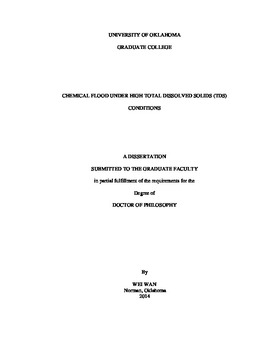| dc.contributor.advisor | Shiau, Benjamin | |
| dc.contributor.author | Wan, Wei | |
| dc.date.accessioned | 2014-08-19T06:41:08Z | |
| dc.date.available | 2014-08-19T06:41:08Z | |
| dc.date.issued | 2014-08-15 | |
| dc.identifier.uri | https://hdl.handle.net/11244/10506 | |
| dc.description.abstract | After the primary and secondary production, there is still a great potential of enhanced oil recovery (EOR). Currently, the high oil price, increase of oil demand and maturing oil fields and the improvement in surfactant performance are generating a new wave of interest in chemical flood. Chemical flood injects surfactants to reduce interfacial tension (IFT) between oil and brine to reduce capillary force to help release oil, and polymers to increase the viscosity of the displacing water for mobility control to increase macroscopic sweep efficiency.
There is a great amount of trapped oil underneath the lands of Oklahoma. The objective of chemical flood was to recover a percentage of the trapped oil. The formation brine in Oklahoma reservoir has a very high salinity (> 10 wt% TDS) with substantial hardness. Thus the main objective of this study was to develop surfactant/polymer formulation for chemical flood in high salinity reservoirs.
Chapter 1 introduces the background and motivation of this study. Chapter 2 introduces the materials and methods used in this study. Chapter 3 presents the characterization of crude oil equivalent alkane carbon number (EACN) for surfactant flooding design, Chapter 4 presents formulating low-IFT microemulsions for high salinity formations using extended surfactants, Chapter 5 presents surfactant/polymer formulation of chemical flood for three high salinity reservoirs. Chapter 6 presents surfactant formulation of chemical flood for a high salinity and temperature reservoir. Chapter 7 summarizes this study and proposes some future work to be done.
Phase behavior test was used to develop surfactant formulation for given oil and brine. Mobility control was achieved by increasing the viscosity of displacing water by using either polymer or wormlike micelles. Once a good and stable surfactant/polymer formulation was developed, sand packed column test and core flood test were used to evaluate the performance of the chemical formulations developed for chemical flood in the laboratory.
The EACN of crude oil determined was 6.0-11.3. This study successfully developed surfactant/polymer formulations for chemical flood for several high salinity reservoirs in the laboratory. The optimal injection strategy using these surfactant/polymer formulations recovered a significant amount (25-73%) of residual oil after water flood in both the sand packed column tests and the core flood tests in the laboratory. | en_US |
| dc.language | en_US | en_US |
| dc.subject | Engineering, Petroleum. | en_US |
| dc.title | Chemical Flood Under High Total Dissolved Solids (TDS) Conditions | en_US |
| dc.contributor.committeeMember | Harwell, Jeffrey | |
| dc.contributor.committeeMember | Roller, Chad | |
| dc.contributor.committeeMember | Jamili, Ahmad | |
| dc.contributor.committeeMember | Devegowda, Deepak | |
| dc.contributor.committeeMember | Ghanbarnezhad-Moghanlo, Rouzbeh | |
| dc.date.manuscript | 2014-08-12 | |
| dc.thesis.degree | Ph.D. | en_US |
| ou.group | Mewbourne College of Earth and Energy::Mewbourne School of Petroleum and Geological Engineering | en_US |
